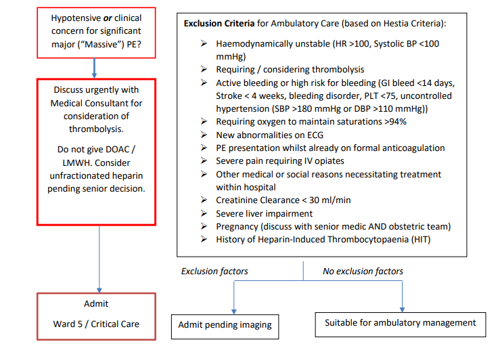
Treatment pending imaging (dose may change if PE confirmed):
Commence whilst awaiting scan if any delay
- 1st choice – Apixaban 10mg BD (see contraindications - page 3)
- 2nd choice – Dalteparin (see NHS Borders dose guidance-weight dependant)
- 3rd choice – If eGFR <30 ml/min consider IV Heparin (discuss with senior)
If ambulatory:
- Give worsening advice including side effects of anticoagulation
- Complete AAU letter / UPR
- Request CTPA
- Book patient into AAU Ward Attenders as early slot as reminder to day team, and tell
patient they will be phoned with a time to attend the next day - Day team then liaise with radiology, confirm time, and phone patient
Considerations for ambulatory treatment pending imaging:
Apixaban is contraindicated in:
- Patients with active cancer
- Intravenous drug users / alcohol misuse/significantly chaotic lifestyle
- Pregnant or recently post-partum patients / breast feeding
- Creatinine Clearance <30ml/min
- CYP3A4 Liver enzyme inhibitors or inducers that may affect active drug levels: e.g. antifungal agents (other than fluconazole),
clarithromycin, phenytoin, phenobarbitone, rifampicin, carbamazepine - Abnormal liver function significant enough to cause abnormal coagulation
- Patient preference (i.e. after discussing options , DOAC is refused due to e.g. lack of reversal agent)
- Known bleeding disorder
- Age <18 years
- Significant falls risk
- Cognitive impairment without adequate carer support to ensure appropriate concordance with treatment
If not for Apixaban, and no specific contraindications to heparin therapy, use Low Molecular Weight Heparin (Dalteparin SC, doses as per local
guidance, or unfractionated if required).



